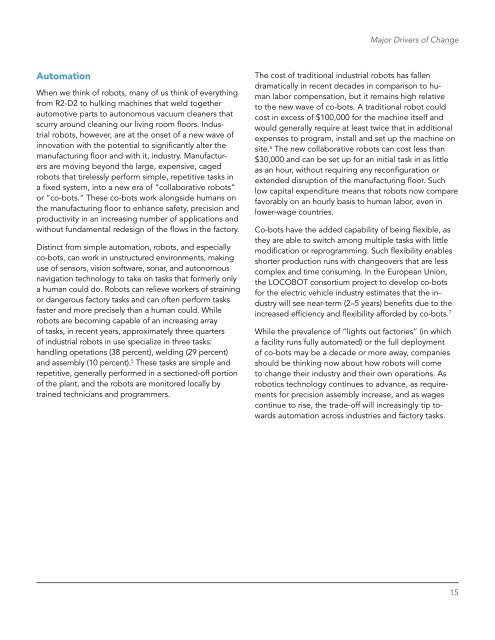Reinventing Manufacturing
eayWVRd
eayWVRd
You also want an ePaper? Increase the reach of your titles
YUMPU automatically turns print PDFs into web optimized ePapers that Google loves.
Major Drivers of Change<br />
Automation<br />
When we think of robots, many of us think of everything<br />
from R2-D2 to hulking machines that weld together<br />
automotive parts to autonomous vacuum cleaners that<br />
scurry around cleaning our living room floors. Industrial<br />
robots, however, are at the onset of a new wave of<br />
innovation with the potential to significantly alter the<br />
manufacturing floor and with it, industry. Manufacturers<br />
are moving beyond the large, expensive, caged<br />
robots that tirelessly perform simple, repetitive tasks in<br />
a fixed system, into a new era of “collaborative robots”<br />
or “co-bots.” These co-bots work alongside humans on<br />
the manufacturing floor to enhance safety, precision and<br />
productivity in an increasing number of applications and<br />
without fundamental redesign of the flows in the factory.<br />
Distinct from simple automation, robots, and especially<br />
co-bots, can work in unstructured environments, making<br />
use of sensors, vision software, sonar, and autonomous<br />
navigation technology to take on tasks that formerly only<br />
a human could do. Robots can relieve workers of straining<br />
or dangerous factory tasks and can often perform tasks<br />
faster and more precisely than a human could. While<br />
robots are becoming capable of an increasing array<br />
of tasks, in recent years, approximately three quarters<br />
of industrial robots in use specialize in three tasks:<br />
handling operations (38 percent), welding (29 percent)<br />
and assembly (10 percent). 5 These tasks are simple and<br />
repetitive, generally performed in a sectioned-off portion<br />
of the plant, and the robots are monitored locally by<br />
trained technicians and programmers.<br />
The cost of traditional industrial robots has fallen<br />
dramatically in recent decades in comparison to human<br />
labor compensation, but it remains high relative<br />
to the new wave of co-bots. A traditional robot could<br />
cost in excess of $100,000 for the machine itself and<br />
would generally require at least twice that in additional<br />
expenses to program, install and set up the machine on<br />
site. 6 The new collaborative robots can cost less than<br />
$30,000 and can be set up for an initial task in as little<br />
as an hour, without requiring any reconfiguration or<br />
extended disruption of the manufacturing floor. Such<br />
low capital expenditure means that robots now compare<br />
favorably on an hourly basis to human labor, even in<br />
lower-wage countries.<br />
Co-bots have the added capability of being flexible, as<br />
they are able to switch among multiple tasks with little<br />
modification or reprogramming. Such flexibility enables<br />
shorter production runs with changeovers that are less<br />
complex and time consuming. In the European Union,<br />
the LOCOBOT consortium project to develop co-bots<br />
for the electric vehicle industry estimates that the industry<br />
will see near-term (2–5 years) benefits due to the<br />
increased efficiency and flexibility afforded by co-bots. 7<br />
While the prevalence of “lights out factories” (in which<br />
a facility runs fully automated) or the full deployment<br />
of co-bots may be a decade or more away, companies<br />
should be thinking now about how robots will come<br />
to change their industry and their own operations. As<br />
robotics technology continues to advance, as requirements<br />
for precision assembly increase, and as wages<br />
continue to rise, the trade-off will increasingly tip towards<br />
automation across industries and factory tasks.<br />
15


